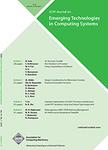版权所有:内蒙古大学图书馆 技术提供:维普资讯• 智图
内蒙古自治区呼和浩特市赛罕区大学西街235号 邮编: 010021

作者机构:Oak Ridge Natl Lab One Bethel Valley Rd Oak Ridge TN 37831 USA
出 版 物:《ACM JOURNAL ON EMERGING TECHNOLOGIES IN COMPUTING SYSTEMS》 (ACM J. Emerg. Technologies Comput. Syst.)
年 卷 期:2018年第14卷第4期
页 面:1–13页
核心收录:
学科分类:0808[工学-电气工程] 08[工学] 0805[工学-材料科学与工程(可授工学、理学学位)] 0812[工学-计算机科学与技术(可授工学、理学学位)]
基 金:United States Department of Defense Laboratory Directed Research and Development Program of Oak Ridge National Laboratory
主 题:Optimization community detection neural network graph algorithm
摘 要:We study the applicability of spiking neural networks and neuromorphic hardware for solving general optimization problems without the use of adaptive training or learning algorithms. We leverage the dynamics of Hopfield networks and spin-glass systems to construct a fully connected spiking neural system to generate synchronous spike responses indicative of the underlying community structure in an undirected, unweighted graph. Mapping this fully connected system to current generation neuromorphic hardware is done by embedding sparse tree graphs to generate only the leading-order spiking dynamics. We demonstrate that for a chosen set of benchmark graphs, the spike responses generated on a current generation neuromorphic processor can improve the stability of graph partitions and non-overlapping communities can be identified even with the loss of higher-order spiking behavior if the graphs are sufficiently dense. For sparse graphs, the loss of higher-order spiking behavior improves the stability of certain graph partitions but does not retrieve the known community memberships.